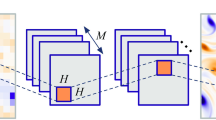Abstract
Accuracy of out-of-plane vorticity estimation from in-plane experimental velocity measurements is investigated with particular application to digital particle image velocimetry (DPIV). Simulations of known flow fields are used to quantify errors associated with amplification of the velocity measurement noise and method bias error due to spatial sampling resolution. A novel, adaptable, hybrid estimation scheme combining implicit compact finite difference and Richardson extrapolation schemes is proposed for improved vorticity estimation. The scheme delivers higher-order truncation error with less noise amplification than an explicit second order finite difference scheme. Finally, a complete framework for predicting, a priori, the random, bias, and total error of the vorticity estimation on the basis of the error of the resolved velocities and the choice of differentiation scheme is developed and presented.









Similar content being viewed by others
Abbreviations
- A, A k :
-
Constants for Richardson extrapolation
- α, β, a, b, c :
-
Constants for the compact schemes
- i, j, k :
-
Indices
- θ , r, z :
-
Coordinate axes (subscripts)
- r :
-
Radius
- Δ, Δx :
-
Spatial sampling resolution
- Γ:
-
Circulation (set to 1,000 mm2/s for Oseen vortex solution)
- Vref :
-
Characteristic velocity scale
- L :
-
Characteristic length scale (set to 130 mm for Oseen vortex solution)
- U :
-
Velocity in i direction
- V :
-
Velocity in j direction
- ω:
-
Out-of-plane vorticity
- σ:
-
Standard deviation
- δ:
-
Uncertainty
- λ o :
-
Noise transmission ratio
- K :
-
Coefficient (numerator) of the noise transmission ratio
- γ, ϕ:
-
Constants for power law
- ɛ:
-
Noise amplification coefficient (probabilistic quadratic approach)
- χ:
-
Constants from velocity derivative schemes evaluated in probabilistic quadratic approach
- FD2:
-
Second-order central finite difference scheme
- Chapra-4:
-
Fourth-order Chapra scheme
- comp-4:
-
Fourth-order compact scheme
- comp-6:
-
Sixth-order compact scheme
- *:
-
Denotes noise optimization
- Rich-4*:
-
Noise optimized fourth-order Richardson extrapolation scheme
- Rich-6:
-
Sixth-order Richardson extrapolation scheme
- CR4*:
-
Noise optimized fourth-order hybrid compact-Richardson extrapolation scheme
References
Abrahamson S, Lonnes S (1995) Uncertainty in calculating vorticity from 2D velocity fields using circulation and least-squares approaches. Exp Fluids 20:10–20
Adrian RJ (1997) Dynamic ranges of velocity and spatial resolution of particle image velocimetry. Meas Sci Technol 8:1393–1398
Chapra SC (1998) Numerical methods for engineers. McGraw Hill, New York
Etebari A, Carneal J, Vlachos P (2004a) On the accuracy of wall shear stress using DPIV. In: Proceedings of the 2004 ASME heat transfer/fluids engineering summer conference
Etebari A, Akle B, Farinholt K, Bennett M, Leo D, Vlachos P (2004b) The use of active ionic polymers in dynamic skin friction measurements. In: Proceedings of the 2004 ASME heat transfer/fluids engineering summer conference
Foucaut JM, Stanislas M, (2002) Some considerations on the accuracy and frequency response of some derivative filters applied to particle image velocimetry vector fields. Meas Sci Technol 13:1058–1071
Fouras A, Soria J (1998) Accuracy of out-of-plane vorticity measurements derived from in-plane velocity field data. Exp Fluids 25:409–430
Hart DP (2000) PIV error correction. Exp Fluids 29:13–22
Huang H, Dabiri D, Gharib M (1997) On errors of digital particle image velocimetry. Meas Sci Technol 8:1427–1440
Lele SK (1990) Compact finite difference schemes with spectral-like resolution, CTR Manuscript 107, NASA Technical Reports
Lourenco L, Krothapalli A (1995) On the accuracy of velocity and vorticity measurements with PIV. Exp Fluids 18:421–428
Luff JD, Drouillard T, Rompage AM, Linne MA, Hertzberg JR (1999) Experimental uncertainties associated with particle image elocimetry (PIV) based vorticity algorithms. Exp Fluids 26:36–54
Marxen M, Sullivan PE, Loewen MR, Jahne B (2000) Comparison of Gaussian particle center estimators and the achievable measurement density for particle tracking velocimetry. Exp Fluids 29:145–153
McKenna SP, McGillis WR (2002) Performance of digital image velocimetry processing techniques. Exp Fluids 32:106–115
Moffat RJ (1988) Describing the uncertainties in experimental results. Exp Thermal Fluid Sci 1:3–17
Nogueira J, Lecuona A, Rodriguez PA (1999) Local field correction PIV: on the increase of accuracy of digital PIV systems. Exp Fluids 27:107–116
Ruan X, Song X, Yamamoto F (2001)Direct measurement of the vorticity field in digital particle image velocimetry. Exp Fluids 30:696–704
Saarenrinne P, Piirto M (2000) Turbulent kinetic energy dissipation rate estimation from PIV velocity vector fields. Exp Fluids Suppl:S300–S307
Sheng J, Meng H, Fox RO (2000) A large eddy PIV method for turbulence dissipation rate estimation. Chem Eng Sci 55:4423–4434
Werely ST, Meinhart CD (2001) Second-order accurate particle image velocimetry. Exp Fluids 31:258–268
Westerweel J, Daribi D, Gharib M (1997) The effect of discrete window offset on the accuracy of cross-correlation analysis of digital PIV recording. Exp Fluid 23:20–28
Acknowledgments
The authors would like to thank Dr. Demetri Telionis for his guidance and support, as well as the National Institute of Standards and Technology (NIST), the National Aeronautics and Space Administration (NASA), and Aeroprobe Corp.
Author information
Authors and Affiliations
Corresponding author
Additional information
A portion of this work was presented at ASME IMECE 2003 conference
An erratum to this article is available at http://dx.doi.org/10.1007/s00348-005-0085-6.
Rights and permissions
About this article
Cite this article
Etebari, A., Vlachos, P.P. Improvements on the accuracy of derivative estimation from DPIV velocity measurements. Exp Fluids 39, 1040–1050 (2005). https://doi.org/10.1007/s00348-005-0037-1
Received:
Revised:
Accepted:
Published:
Issue Date:
DOI: https://doi.org/10.1007/s00348-005-0037-1




